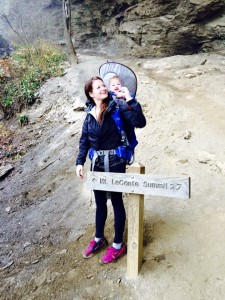By Annadele Herman
As spry as ever, the National Park Service is gearing up to celebrate a centennial anniversary this month! The service has been celebrating past successes this year through a slew of initiatives geared toward getting Americans outside. The >>AT Hike 100 challenges Americans to hike 100 miles over the course of the year. The >>Every Kid in a Park Initiative grants free admission to any national park for 4 th graders and their families. Several >>free entrance days are already on the books with more planned.
But the next 100 years of conservation, education, and recreation in our national parks is far from assured.
Like millions of others, I love the ritual of a long hike. I love the familiar weight of the pack, so unbearable for the first mile that I question my sanity, then lighter, and suspiciously more burdensome as the day winds to a close until I suspect that a leprechaun has been sneaking rocks into the pack. I revel in the joys and disappointments of what could possibly be around the next curve, the next mile, the next peak. I even tolerate the feeling of the morning dew on my skin, more stale than refreshing, upon waking after an evening spent half dozing and half marveling at the stars.
But it’s the unexpected that holds hikers captive to the allure of the next mountaintop, valley, or canyon. There was the time we were awakened by Pepe, the aptly named amorous alpaca who had taken quite a shine to my boyfriend, much to my delight and his dismay. There was a stray dog we dubbed Copernicus who hiked with us for days and even steered us back to the trail when we’d wandered off (yes, really!). Then there are the occasional mudslides, unexpected storms, and critters along the journey, the shocking impact of sheer darkness on a cloudy evening after sunset when you’re lost, and how difficult each breath becomes at high altitude.
Oh yes, it’s the surprises of nature that capture our imaginations – that remind us of our very humanity. It’s coming home.
I’m far from alone in my adulation of our national parks. Every year, Americans spend $646 billion on outdoor recreation. That is nearly twice the amount spent on pharmaceuticals or motor vehicles. This spending leads to $37.2 billion raised nationally in federal, state, and local tax revenue, only a fraction of which we reinvest back into preserving our national parks. In fact, the average household currently spends about the cost of a cup of coffee in levied taxes in order to maintain our natural spaces. The cuts of the economic recession left a $11.3 billion maintenance backlog in their wake. Last year’s budget increased to address some of this backlog by a billion dollars but the bulk of it remains.
Luckily, investing in our parks for the next 100 years is one of the few things we can all agree on. Nine out of 10 voters from any party want to see park funding increase or stay the same. Even if you’ve never stepped foot in one of our over 400 national parks or programs, chances are you value their mere existence. According to responses of a survey conducted this year, which aimed to estimate the value of the parks for the first time in the eyes of voters, 85% of Americans feel parks benefitted them whether they visited or not. The survey’s >>very conservative estimate placed the national parks’ value at $92 billion.
As you celebrate the momentous 100 th year anniversary with >>free entrance to the Grand Canyon, Yosemite, or Denali National Parks, at the >>Centennial celebration on our own Mt. Mitchell , or via a stroll in any of our many local parks, consider their future and how much they’re worth to you.
And if you should come across our friend, Pepe, the amorous alpaca, tell him I said “MEEP!” Next time, we’ll get him.


There are no comments
Add yours